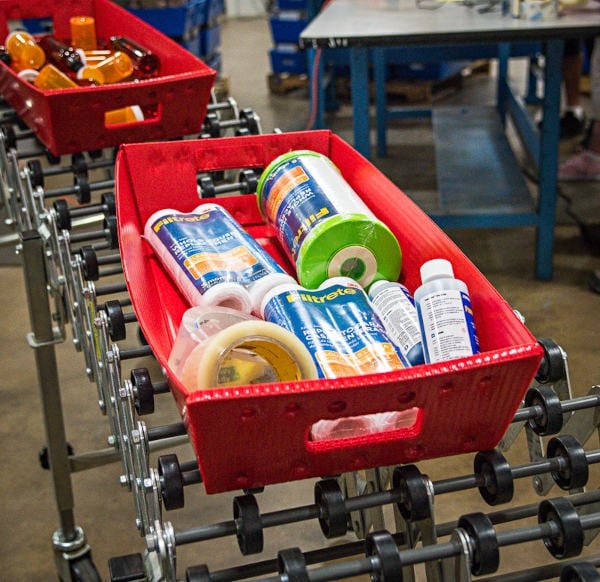Proper planning and implementation of warehouse strategies are critical for efficient operation as it directly impacts the success of a business. A well-run warehouse ensures timely and accurate order fulfillment, optimizes storage space, reduces costs, and improves overall customer satisfaction.
Here are comprehensive and practical warehouse strategy plans essential for a company’s long-term success and sustainability.
Inventory Management Strategies
 Inventory management strategies aim to balance the cost of holding too much inventory with the cost of stockouts.
Inventory management strategies aim to balance the cost of holding too much inventory with the cost of stockouts.
Stock Classification
Stock classification is a warehouse strategy plan used in inventory management to categorize and prioritize items in a company’s stock or inventory based on various criteria such as sales volume, importance, and urgency. This classification is an inventory management strategy that helps companies decide which products to keep in stock, how much to order, and when to reorder.
Inventory Control Techniques (FIFO, LIFO, FEFO)
Warehouses use inventory control techniques to manage and track the flow of goods and materials in a company’s inventory.
- In First In, First Out (FIFO): The oldest items in the stock are sold or used first, which aligns with the idea of selling goods with the shortest shelf life first.
- Last In, First Out (LIFO): The newest items in the inventory are sold or used first. This warehouse strategy method gets utilized in industries where prices increase, and companies want to use the lower-cost goods first.
- First Expired First Out (FEFO): Similar to FIFO, but focuses on expired products. The products that will expire first are sold or used first to avoid spoilage or waste.
Use of these inventory management strategies can effectively track inventory to improve warehouse operations and efficiency.
Safety Stock Management
Safety stock is a type of inventory management warehouse strategy that involves keeping a minimum amount of extra stock on hand to mitigate the risk of running out of inventory due to uncertainty in demand or supply. It helps ensure that a company can meet customer demand despite unexpected fluctuations or delays in the supply chain.
Cycle Counting
Cycle counting is an inventory management technique that involves regularly counting a small subset of items in an inventory instead of counting the entire stock in one go. It aims to maintain accurate inventory records, detect discrepancies, and identify any issues with the inventory management process.
Warehouse Space Optimization Strategies
Warehouse space optimization strategies aim to maximize the utilization of available space while reducing costs and improving efficiency. Here are some common techniques.
Layout Design
Layout design is an inventory management strategy that involves arranging and organizing the storage and movement of goods within a warehouse to maximize efficiency and minimize waste of space. A well-designed warehouse layout improves productivity, reduces lead time, increases accuracy, and enhances overall customer satisfaction.
Storage Techniques (Bulk, Flow, Pallet)
Bulk storage involves stacking items in large quantities without any specific organization, making it a cost-effective option for storing large amounts of non-perishable items.
On the other hand, flow storage involves using conveyor systems and gravity to move items through the warehouse and onto shelves, optimizing space utilization and reducing the need for manual handling.
Lastly, pallet storage involves storing items on pallets and utilizing space vertically, maximizing available space while allowing for easy access to individual goods.
Rack Configuration
Rack configuration is a space-optimization warehouse strategy that involves arranging shelves, pallets, or other storage systems in a specific way to maximize storage density and efficiency. Proper rack configuration helps reduce wasted space, improve organization and inventory control, and increase productivity.
Vertical Storage Solutions
Vertical storage solutions use vertical space within a warehouse for storage. It includes shelving systems, mezzanine structures, and vertical lift systems. By maximizing vertical space, these solutions significantly increase storage capacity within a warehouse, reducing the need for additional square footage.

Warehouse Labor Management Strategies
Here are several strategies that help effectively manage labor during warehouse operations.
Workforce Planning
Workforce planning involves forecasting labor demand based on factors, such as incoming orders, seasonal fluctuations, and changes in operating procedures. From there, you will need to ensure that the correct number of employees is available to meet those demands.
Effective workforce planning requires careful analysis of historical data, collaboration with departments across the organization, and regular reassessment to account for changes in the business environment.
Employee Training and Development
Companies improve productivity, reduce errors and accidents, and increase employee job satisfaction by providing workers with the skills and knowledge they need to perform their jobs effectively.
You can achieve employee training and development through various methods, including on-the-job training, online courses, workshops and seminars, and formal classroom-style training programs.
Labor Scheduling and Optimization
Labor scheduling and optimization is a warehouse strategy aiming to maximize warehouse labor’s efficiency and productivity by balancing the workload, allocating the right resources, and reducing labor costs.
It is done by analyzing data on worker performance, shifts, workload, and other variables and using algorithms and tools to create schedules that meet the enterprise’s needs while ensuring employees’ fair treatment.
Performance Tracking and Management
Performance tracking and management involve regularly monitoring the performance of employees and using this information to identify areas for improvement and to motivate workers to achieve their full potential.
You can achieve this through various methods, including performance appraisals, regular feedback sessions, and setting performance goals.
Warehouse Material Handling Equipment
Warehouse material handling equipment refers to the tools and devices used to efficiently move, store, and control products and materials within a warehouse setting. Here are some warehouse material handling equipment strategies.
Equipment Selection
Equipment selection directly impacts warehouse operations’ efficiency, safety, and cost-effectiveness. The proper equipment selection improves material handling processes, reduces operational costs, increases storage capacity, and enhances overall productivity.
Maintenance and Upkeep
Maintenance and upkeep entail regular inspection, cleaning, and repair of equipment to prevent breakdowns, reduce downtime, and maintain optimal performance. Keeping equipment in good condition helps ensure workers’ safety and prevents accidents.
Equipment Optimization
Equipment optimization is a warehouse strategy plan used in warehouse material handling to improve the efficiency and effectiveness of the equipment used in the warehouse. It involves evaluating the current equipment and processes, identifying areas for improvement, and implementing changes to optimize the performance of the equipment.
Automated Material Handling Solutions
Automated material handling solutions use robotics, conveyors, and software systems to streamline and optimize material handling processes in a warehouse setting. This warehouse strategy plan aims to increase efficiency, accuracy, and productivity while reducing manual labor and minimizing errors.
Warehouse Technology and Automation
Warehouse technology and automation refer to the use of advanced technologies and equipment to streamline and optimize various processes within a warehouse environment.
Warehouse Management Systems
A warehouse management system (WMS) is a software platform that helps manage and automate critical operations in a warehouse. It helps improve inventory accuracy, increase productivity, and reduce operating costs.
Some functions of a WMS include receiving and shipping goods, storing and retrieving goods, order picking, stock management, and reporting.
Barcode and RFID Technology
Barcode technology involves scanning barcodes on products to identify and track them. This warehouse operation technology is low-cost, easily implemented, and widely used in many warehouses.
Radio-frequency identification (RFID) technology uses radio waves to transmit data from a tag attached to an item to a reader. This technology tracks objects in real time and provides more information about a commodity than a barcode, making it an effective warehouse strategy plan.
Robotics and Automated Guided Vehicles (AGVs)
Robotics handles tasks such as picking, packing, and sorting, freeing human workers from repetitive manual labor. On the other hand, AGVs are automated vehicles that transport materials and goods within a warehouse, reducing the need for manual handling and increasing efficiency.
IoT and Smart Warehouse Solutions
Internet of things (IoT) devices, such as sensors and RFID tags, provide real-time data about the location and status of inventory, allowing for more efficient tracking and management.
Smart warehouse solutions, such as warehouse management systems and warehouse control systems (WCS), use this data to automate inventory tracking, order fulfillment, and material handling processes.
Performance Measurement and Continuous Improvement
Here are performance measurement and continuous improvement strategies.
Key Performance Indicators
Key performance indicators (KPIs) are metrics used to evaluate the performance of an organization, a department, a project, or an individual against specific business objectives and goals. KPIs are selected based on the organization’s strategic objectives and help to determine the success or progress of a particular activity.
Data Analysis and Metrics Tracking
By collecting, analyzing, and tracking data, organizations gain insights into their operations and identify areas for improvement. Data analysis and metrics tracking help organizations make data-driven decisions and improve overall performance over time.
Root Cause Analysis
Root cause analysis (RCA) is a problem-solving method used to identify the underlying causes of an issue to prevent it from happening again. In the context of performance measurement and continuous improvement, RCA helps identify areas of underperformance and improve processes.
Continuous Improvement Programs
Continuous improvement programs (CIPs) are a warehouse strategy to continuously improve the performance of organizations, processes, and systems. This measurement, analysis, implementation, and monitoring cycle is repeated over time to drive continuous improvement.
Your Strategies for Warehouse Success
Effective warehouse operations play a crucial role in the success of any business. The use of technology such as warehouse management systems and automation help streamline processes and make the most of available resources. A well-executed warehouse strategy plan is adaptable and continuously improving in today’s fast-paced business environment.
For help with effective warehouse organization strategies, contact us today.